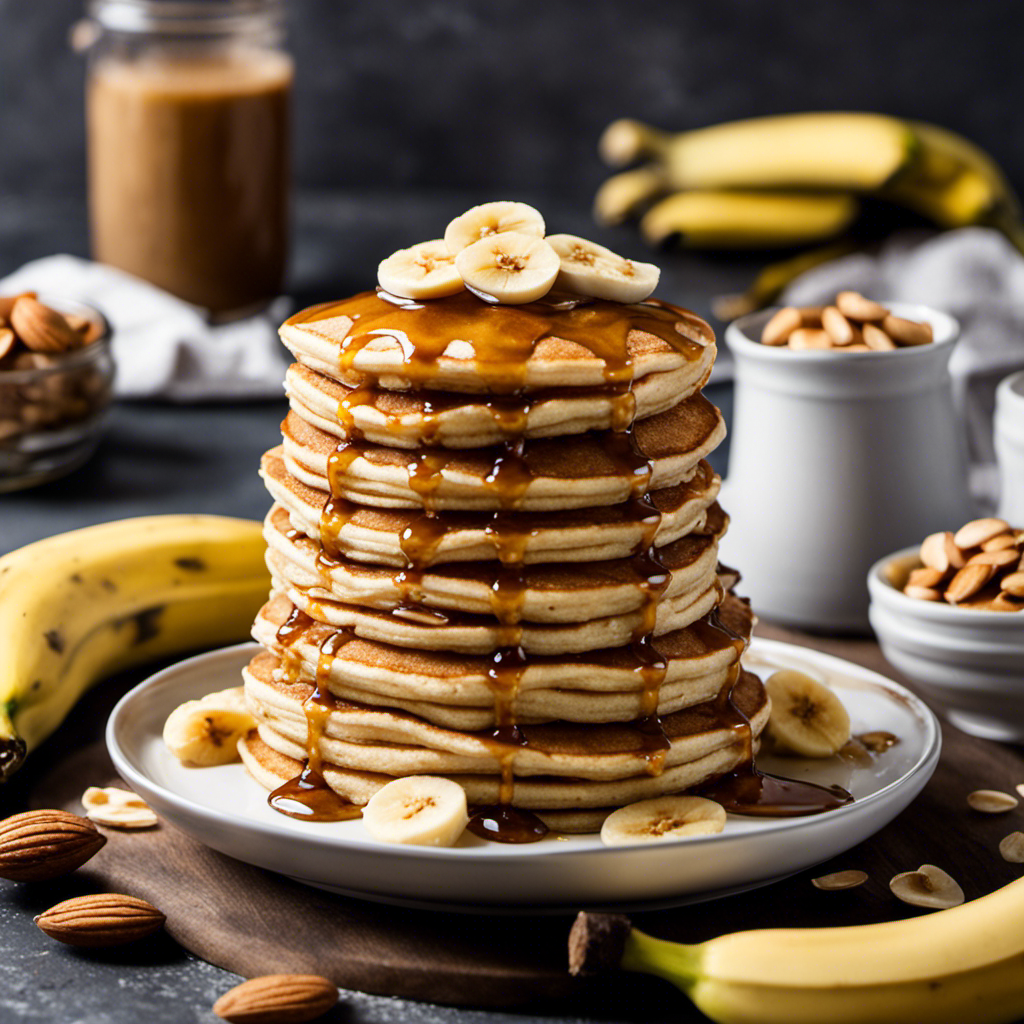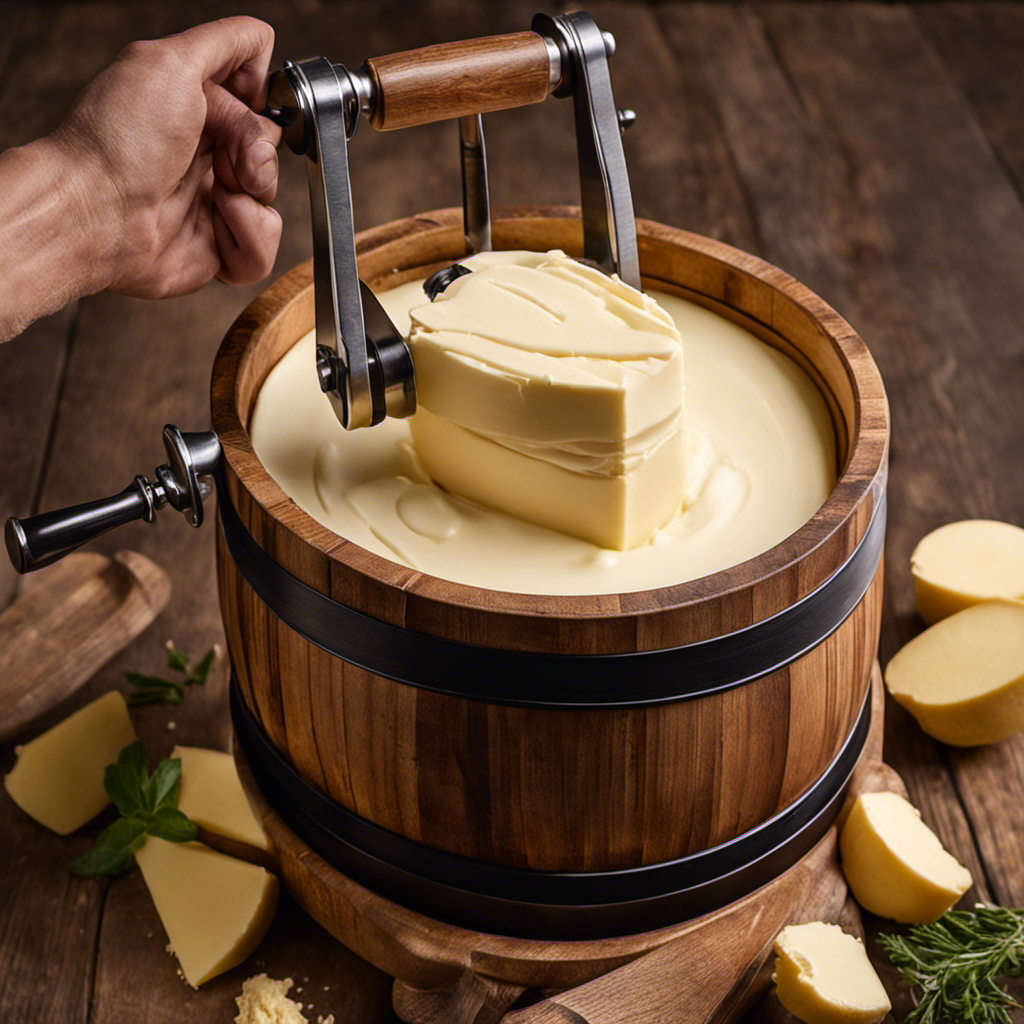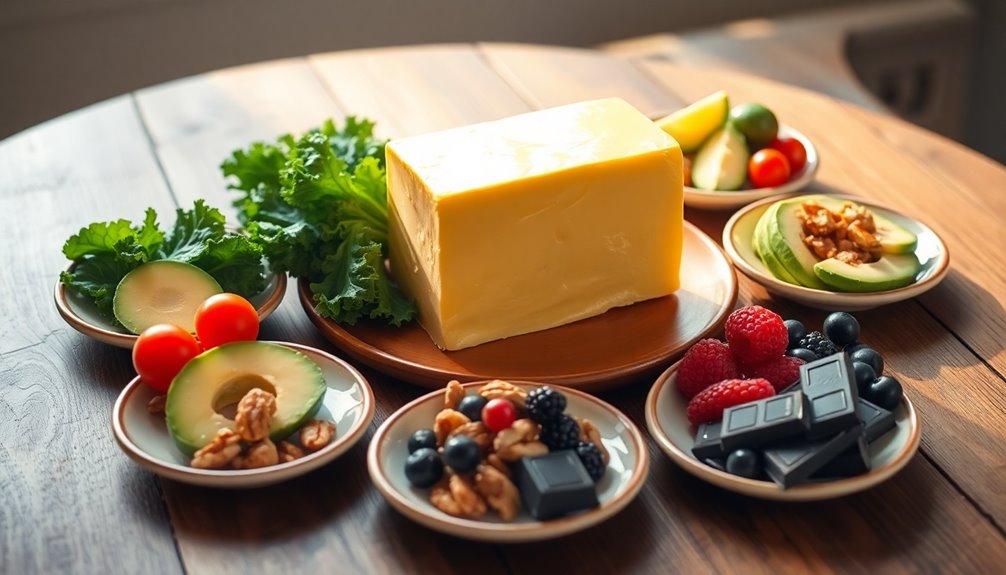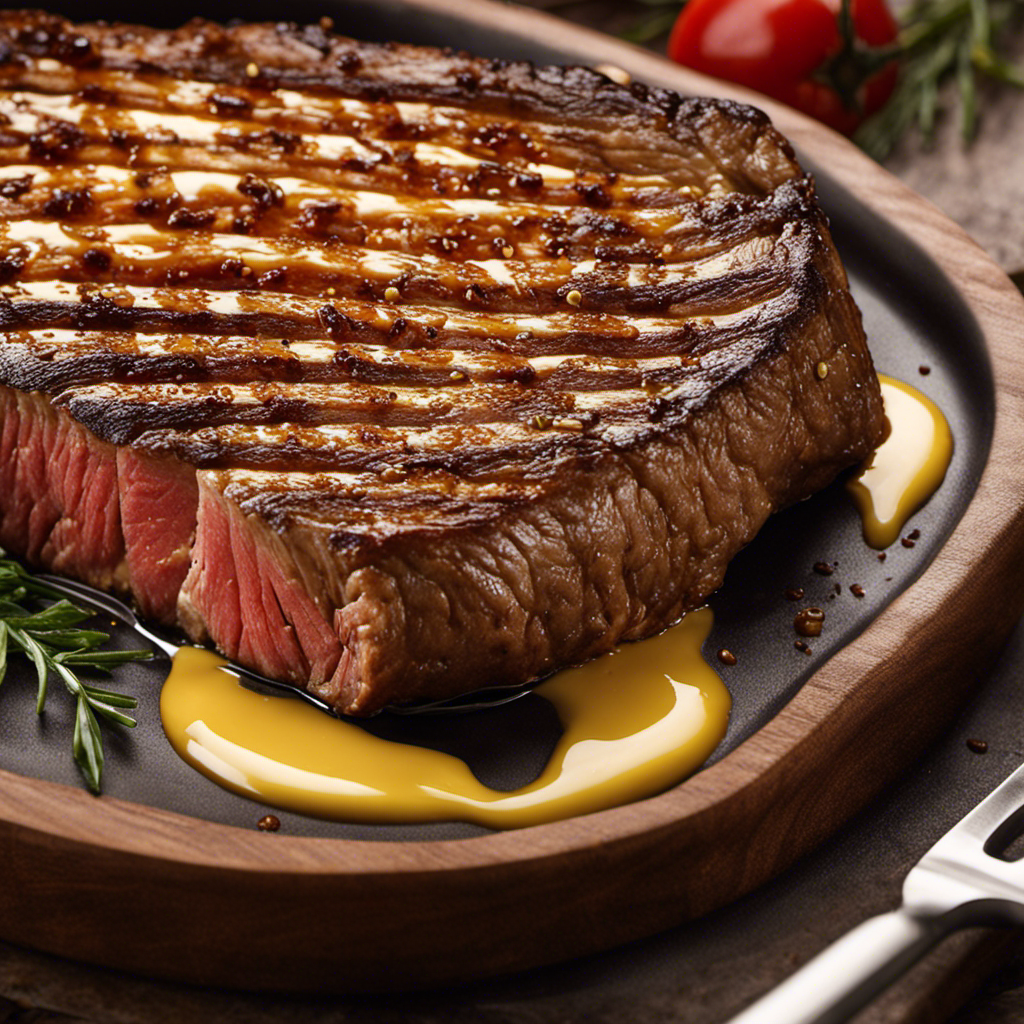Spreading the creamy, golden cookie butter on a piece of warm toast immediately transports me to a place of delicious delight.
The rich and creamy flavor of this decadent spread begs the question: what else can I pair it with?
In this article, I will guide you through a mouthwatering journey of delectable combinations, from sweet treats to unexpected pairings.
Get ready to elevate your cookie butter experience and unlock a whole new realm of culinary delight.
Key Takeaways
- Cookie butter can be used in a variety of sweet treats and desserts, such as chocolate chip cookies, croissants, ice cream, and pancakes.
- It can also be enjoyed as a breakfast option by spreading it on toast, pairing it with different types of cheese, adding it to oatmeal or yogurt, or using it as a filling for crepes or French toast.
- For savory options, cookie butter can be used as a marinade for grilled chicken or tofu, mixed into salad dressings, used as a glaze for roasted vegetables, or spread on crackers or pretzels as a savory snack.
- When it comes to snack time, cookie butter can be paired with fruit, spread on graham crackers or vanilla wafers, dipped with celery or carrot sticks, or enjoyed with soft pretzels or pretzel chips.
Sweet Treats
You should try making chocolate chip cookies to enjoy with your cookie butter. These delectable treats are the perfect accompaniment to your morning cup of coffee or as an indulgent afternoon snack. The warm, gooey centers and crispy edges of homemade chocolate chip cookies perfectly complement the rich and creamy texture of cookie butter.
For a delightful breakfast treat, you could also whip up some breakfast pastries, such as flaky croissants or buttery scones, and spread a generous amount of cookie butter on top. The combination of the flaky pastry and the sweet, nutty flavors of the cookie butter creates a heavenly indulgence that will surely satisfy your cravings.
If you’re feeling adventurous, why not create your own homemade ice cream and drizzle some cookie butter over it? The creamy ice cream paired with the smooth and velvety cookie butter is a match made in dessert heaven. The sweet and salty flavors will dance on your taste buds, leaving you craving for more.
Breakfast Ideas
When it comes to breakfast, there are endless options to choose from. One of the main decisions I often make is whether I want something sweet or savory to start my day.
While I can’t resist indulging in a stack of fluffy pancakes topped with syrup, I also enjoy the satisfaction of a nutritious and healthy breakfast packed with veggies and protein.
Sweet or Savory Dishes
If you’re craving something sweet or savory to pair with cookie butter, try spreading it on toast or using it as a dip for pretzels or potato chips. It may sound unusual, but trust me, the combination is absolutely delightful.
Here are some more creative ideas to satisfy your sweet and savory cravings:
- Spread cookie butter on warm pancakes or waffles for a decadent breakfast treat.
- Use it as a filling for crepes and top with fresh berries.
- Make a cookie butter and banana sandwich for a quick and easy snack.
- Pair cookie butter with different types of cheese, like brie or gouda, for a unique flavor combination.
The possibilities are endless when it comes to enjoying cookie butter. So go ahead, get creative, and indulge in these delicious sweet and savory snack ideas.
Healthy Options or Indulgent?
Whether you prefer a healthier choice or something more indulgent, there are plenty of options to satisfy your cravings. When it comes to cookie butter, it’s easy to think of it as a sweet treat, perfect for spreading on toast or dipping fruit into.
But did you know that there are also healthy alternatives and ways to incorporate cookie butter into savory dishes? One option is to use it as a marinade for grilled chicken or tofu, adding a touch of sweetness and depth of flavor. You can also mix it into salad dressings or use it as a glaze for roasted vegetables.
The possibilities are endless when it comes to incorporating cookie butter into savory dishes, so go ahead and get creative in the kitchen!
Snack Time Delights
When it comes to snack time, I love exploring the world of sweet and savory pairings. There’s something magical about the combination of flavors that just works so well together.
In this discussion, I’ll be sharing some quick and easy recipes that showcase these delicious duos, as well as some unexpected flavor combinations that will leave your taste buds tingling with delight.
Get ready to embark on a flavor adventure like no other!
Sweet and Savory Pairings
You can try pairing cookie butter with sweet options like fruit or savory options like pretzels for a delicious combination. Cookie butter is a versatile spread that can be enjoyed in many different ways.
Here are some healthy and indulgent options for unique flavor pairings with cookie butter:
-
Sliced apples or strawberries: The natural sweetness of the fruit complements the rich and creamy taste of the cookie butter.
-
Graham crackers or vanilla wafers: These crunchy snacks provide a perfect base for spreading cookie butter, adding a delightful texture to each bite.
-
Celery sticks or carrot sticks: For a healthier option, dip these crunchy vegetables into cookie butter for a satisfying and nutritious snack.
-
Soft pretzels or pretzel chips: The salty and savory taste of pretzels pairs surprisingly well with the sweet and nutty flavor of cookie butter.
With these creative pairings, you can elevate your cookie butter experience and enjoy a truly indulgent treat.
Quick and Easy Recipes
Try these quick and easy recipes for a delicious and satisfying meal in no time.
Start your day off right with a refreshing breakfast smoothie. Blend together frozen berries, a ripe banana, Greek yogurt, and a splash of almond milk. The result is a creamy and nutritious smoothie that will keep you full until lunchtime.
For a sweet treat that requires no baking, whip up a batch of no-bake desserts. Combine crushed cookies, melted butter, and cookie butter in a bowl. Press the mixture into a baking dish and refrigerate until firm. Cut into squares and indulge in the decadent flavors of cookie butter.
These recipes are just the beginning of the wonderful world of unexpected flavor combinations.
Unexpected Flavor Combinations
Mixing contrasting flavors can create unexpectedly delicious taste combinations. When it comes to cookie butter, there are endless possibilities for incorporating it into savory dishes. Here are some healthy and savory options to try:
-
Spread cookie butter on a warm, toasted bagel and top it with sliced avocado for a creamy and satisfying breakfast.
-
Use cookie butter as a glaze for roasted vegetables like carrots or Brussels sprouts. The sweet and nutty flavors will add a unique twist to your side dish.
-
Make a savory dipping sauce by mixing cookie butter with soy sauce, garlic, and ginger. It pairs perfectly with chicken or shrimp skewers.
-
Create a savory salad dressing by whisking together cookie butter, olive oil, Dijon mustard, and apple cider vinegar. It will add a delightful sweetness to your greens.
Now that we’ve explored cookie butter in savory dishes, let’s move on to the delightful combination of cookie butter and fruit pairings.
Cookie Butter and Fruit Pairings
Indulge in the delicious combination of cookie butter and fruit for a sweet and tangy flavor explosion. The creamy, nutty taste of cookie butter perfectly complements the natural sweetness of fresh fruits. It’s a match made in dessert heaven! To give you some mouth-watering inspiration, here are some fantastic cookie butter and fruit pairings:
| Fruit | Cookie Butter Pairing |
|---|---|
| Apples | Classic and comforting |
| Bananas | Creamy and dreamy |
| Strawberries | Sweet and tart |
| Pineapple | Tropical delight |
Imagine biting into a juicy apple slice dipped in cookie butter, or spreading cookie butter on a warm banana. For a unique twist, try making a dessert pizza with a cookie butter spread as the base and topping it with your favorite fruits. The possibilities are endless when it comes to this delightful combination. So go ahead, get creative, and let your taste buds savor the magic of cookie butter and fruit!
Dessert Creations
When it comes to creating desserts, the possibilities are endless. From unique flavor combinations to creative presentation ideas, there’s always room for innovation and experimentation.
Whether it’s adding unexpected ingredients to classic recipes or finding new ways to showcase your creations, dessert making offers a world of opportunities for culinary exploration.
The versatility in recipes allows for endless variations and adaptations, ensuring that there’s something for every taste and occasion.
Unique Flavor Combinations
Try experimenting with different flavor combinations to enhance your cookie butter experience. Here are some unique ideas to elevate your sweet and savory cookie butter recipes:
- Spread cookie butter on toast and top it with sliced bananas and a sprinkle of cinnamon for a delicious breakfast treat.
- Mix cookie butter into your pancake batter for a sweet twist on a classic breakfast favorite.
- Use cookie butter as a filling for homemade donuts or stuffed French toast for an indulgent brunch option.
- Incorporate cookie butter into your savory dishes by using it as a glaze for roasted chicken or pork, adding a touch of sweetness and richness to the meat.
Don’t be afraid to get creative in the kitchen and explore the versatility of cookie butter. It’s not just for desserts anymore!
Creative Presentation Ideas
Get creative with how you present your cookie butter creations – think outside the box and surprise your guests with unique and eye-catching serving ideas.
Presentation techniques can elevate the enjoyment of cookie butter and make it an unforgettable experience for your guests.
One idea is to serve cookie butter in mini mason jars, layering it with crushed cookies or granola for added texture.
Another option is to make cookie butter truffles, rolling the creamy spread into bite-sized balls and dusting them with powdered sugar or cocoa powder.
For a fun twist, try serving cookie butter as a dip alongside a platter of fresh fruit, pretzels, or even cinnamon sugar tortilla chips.
The possibilities are endless when it comes to serving suggestions for cookie butter – let your imagination run wild and create a memorable culinary experience for everyone to enjoy.
Versatility in Recipes
When it comes to cooking with cookie butter, the possibilities are endless. This versatile ingredient can be used in a variety of recipes, adding a rich and indulgent flavor to both sweet and savory dishes.
Here are some cooking techniques that showcase the versatility of cookie butter:
-
Baking: Incorporate cookie butter into cookies, cakes, or brownies for a delicious twist on classic recipes.
-
Spreading: Simply spread cookie butter on toast, pancakes, or waffles for a decadent breakfast treat.
-
Dipping: Use cookie butter as a dip for fruits, pretzels, or even chicken nuggets for a unique and tasty appetizer.
-
Mixing: Add cookie butter to ice cream, yogurt, or smoothies for a creamy and flavorful dessert option.
With these cooking techniques, you can explore the many ways to enjoy the scrumptious taste of cookie butter in your favorite dishes. Get creative and let your taste buds be your guide!
Savory Combinations
You can’t go wrong with spreading cookie butter on crackers or pretzels for a savory snack. But did you know that cookie butter can also be a delicious addition to your dinner ideas?
One of my favorite ways to incorporate this sweet and creamy spread into a savory dish is by using it as a glaze for roasted vegetables. Simply mix some cookie butter with a bit of olive oil, garlic powder, and salt, then coat your veggies before roasting them in the oven. The cookie butter adds a unique sweetness that perfectly complements the savory flavors of the vegetables.
Another fantastic dinner option is to use cookie butter as a sauce for grilled chicken or pork. The richness of the cookie butter pairs wonderfully with the smoky charred flavors of the meat.
Cookie Butter Dips and Spreads
Try spreading this delectable spread on your favorite crackers or bread for a tasty snack. Cookie butter isn’t just for eating straight from the jar; it can be transformed into a variety of sweet and savory spreads and dessert dips.
Here are a few delicious ideas to try:
-
Cookie Butter Cream Cheese Spread: Mix softened cream cheese and cookie butter together until smooth and creamy. Spread it on bagels or toast for a decadent breakfast treat.
-
Cookie Butter Fruit Dip: Combine cookie butter with Greek yogurt and a dash of cinnamon. Serve with fresh fruit for a healthy and indulgent snack.
-
Cookie Butter Nutella Dip: Warm up a mixture of cookie butter and Nutella for a gooey, chocolatey dip. Dip pretzels, marshmallows, or fruit into this irresistible combination.
-
Cookie Butter Honey Butter: Whip together softened butter, cookie butter, and honey for a sweet and creamy spread. Slather it on warm biscuits or pancakes for a mouthwatering treat.
These spreads and dips are perfect for parties, brunches, or simply enjoying on your own.
Now, let’s move on to the next section and explore the world of cookie butter cocktails.
Cookie Butter Cocktails
Now that we’ve explored the world of cookie butter dips and spreads, let’s move on to a more exciting realm – cookie butter cocktails! Believe me, you don’t want to miss out on the deliciousness that awaits.
Cookie butter mocktails are a perfect way to indulge in the flavors of cookie butter while enjoying a refreshing drink. Think creamy milkshakes infused with cookie butter, topped with whipped cream and a sprinkle of cookie crumbs. Or perhaps a cookie butter martini, with a smooth blend of vodka, cream, and cookie butter syrup, garnished with a cookie butter cookie.
But the fun doesn’t stop there. You can also experiment with cookie butter infused desserts. Imagine cookie butter cheesecake, with a buttery cookie crust and a creamy filling infused with the rich flavors of cookie butter. Or how about cookie butter ice cream, with swirls of cookie butter throughout, providing a delightful crunch with every bite.
With these cookie butter cocktails and infused desserts, the possibilities are endless. Get creative and indulge in the irresistible flavors of cookie butter!
Cookie Butter-Inspired Baked Goods
If you’re craving a sweet treat, there’s nothing better than sinking your teeth into a warm, gooey cookie butter-inspired baked good. The combination of sweet and savory cookies with the rich, creamy cookie butter filling is simply irresistible.
Here are some mouthwatering options to satisfy your cravings:
-
Cookie butter-filled donuts: Imagine biting into a fluffy donut filled with a luscious cookie butter center. It’s a match made in dessert heaven.
-
Cookie butter-stuffed brownies: Indulge in the fudgy goodness of a chocolate brownie, with a surprise cookie butter filling that oozes out with every bite.
-
Cookie butter-filled croissants: Take your breakfast pastry to the next level with a flaky croissant filled with warm, melty cookie butter.
-
Cookie butter-filled muffins: Start your day off right with a soft, moist muffin bursting with the sweet and nutty flavors of cookie butter.
These delectable treats will satisfy any sweet tooth and leave you craving for more. But if you’re looking for a cool and refreshing option, let me introduce you to the world of cookie butter ice cream and milkshakes.
Cookie Butter Ice Cream and Milkshakes
Satisfy your sweet tooth with the irresistible combination of creamy cookie butter in the form of ice cream and milkshakes.
Indulging in the velvety smoothness of cookie butter ice cream is like taking a bite of heaven. The rich, buttery flavor of cookie butter swirls through every spoonful, leaving you craving for more. The ice cream is perfectly balanced, not overly sweet, with hints of cinnamon and caramel.
As you take a sip of a cookie butter milkshake, you’re instantly transported to a world of pure bliss. The thick, luscious shake is blended with generous amounts of cookie butter, creating a symphony of flavors in your mouth. The smooth and creamy texture makes it a delightful treat for any time of the day.
And if you’re feeling adventurous, you can even try making cookie butter pancakes or cookie butter smoothies. The possibilities are endless when it comes to satisfying your cookie butter cravings.
Unexpected Cookie Butter Pairings
Indulge in the unexpected pairing of cookie butter with savory dishes like roasted chicken or grilled vegetables. The sweet and salty combination creates a unique and tantalizing flavor experience.
Here are some exciting ways to enjoy cookie butter in unexpected ways:
- Spread cookie butter on a burger for a sweet and savory twist.
- Mix cookie butter into a marinade for grilled steak or pork chops.
- Use cookie butter as a glaze for roasted carrots or Brussels sprouts.
- Incorporate cookie butter into a dipping sauce for chicken tenders or fries.
But it doesn’t stop there! Cookie butter can also be a delicious addition to cocktails. Try mixing it with vodka, cream liqueur, and a splash of cinnamon for a decadent dessert-inspired drink.
Frequently Asked Questions
Can I Use Cookie Butter as a Substitute for Peanut Butter?
Sure, you can absolutely use cookie butter as a substitute for peanut butter! It’s a delicious alternative that adds a unique flavor to your recipes. Try it in sandwiches, smoothies, or even as a dip for fruits and veggies.
Are There Any Vegan Options for Using Cookie Butter in Recipes?
When it comes to vegan cookie butter desserts, the possibilities are endless. From vegan cookie butter brownies to cookie butter banana bread, you can satisfy your sweet tooth without compromising your dietary preferences. And if you’re looking for cookie butter alternatives, try nut butters like almond or cashew for a similar creamy and decadent taste.
Can I Use Cookie Butter in Savory Dishes?
Yes, cookie butter can be used in savory dishes for a unique twist! Try spreading it on toast with avocado and a sprinkle of sea salt, or use it as a glaze for roasted vegetables. Get creative with your cookie butter recipes!
How Long Does Cookie Butter Last Once Opened?
Once opened, cookie butter typically lasts for about 3 to 4 months. To extend its shelf life, store it in a cool, dry place and ensure the lid is tightly sealed. Enjoy this delicious spread on toast, pancakes, or even as a dip for fruit!
Can I Use Cookie Butter as a Topping for Pancakes or Waffles?
Sure, you can definitely use cookie butter as a topping for pancakes or waffles! It adds a sweet and creamy flavor that pairs perfectly with the fluffy texture of pancakes or the crispy edges of waffles. Give it a try!
Conclusion
In conclusion, exploring the world of cookie butter has been a delectable journey filled with endless possibilities.
As I savor the last bite of my cookie butter-infused dessert, I can’t help but appreciate the symbolism behind this culinary adventure.
Just like the creamy, rich cookie butter enhances any treat it’s paired with, we too have the power to enhance our lives by embracing new experiences.
So, let cookie butter be a reminder to savor the sweetness in life and never be afraid to try something unexpected.










